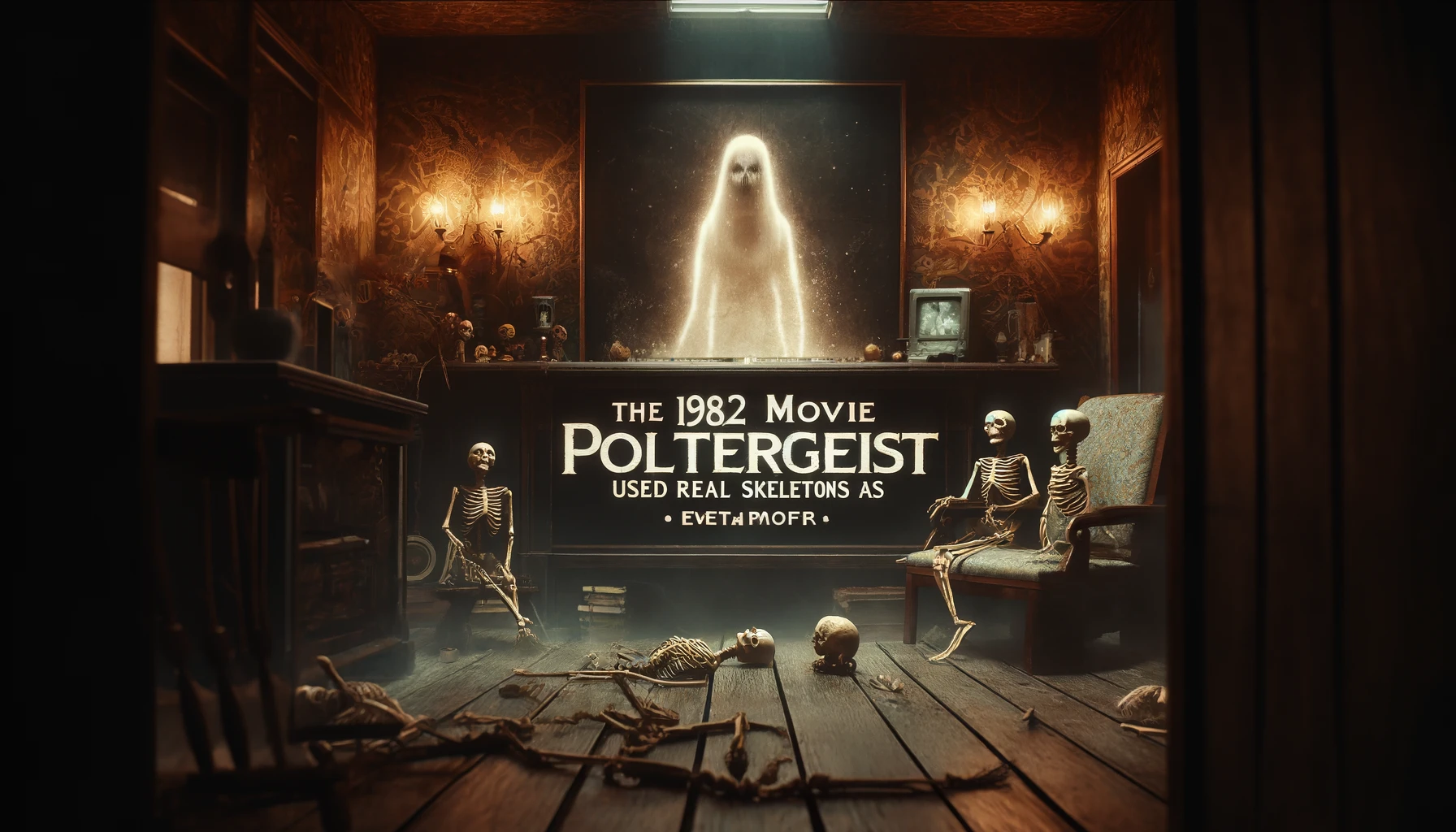
Introduction: The Chilling Reality Behind Poltergeist
The 1982 film Poltergeist, directed by Tobe Hooper and produced by Steven Spielberg, has become a classic in the horror genre. However, beyond its cinematic achievements and the terror it inspired, there lies a chilling behind-the-scenes story that has intrigued and horrified fans for decades. The use of real human skeletons during the filming, particularly in the infamous pool scene, has sparked endless debate and speculation. While Hollywood is no stranger to employing unconventional and sometimes controversial methods to achieve authenticity, the decision to use real skeletons in Poltergeist has led to discussions about the ethical boundaries in filmmaking. This article delves into the reasons behind this eerie choice, the reactions from those involved, and the lasting impact it has had on both the movie and the horror genre as a whole.
The Infamous Pool Scene: Fact or Fiction?
One of the most iconic and terrifying scenes in Poltergeist occurs when Diane Freeling, played by JoBeth Williams, falls into a muddy, water-filled excavation site and encounters several skeletons. The sheer realism of this moment has left audiences wondering if the bones were real. Unfortunately, the answer is yes. JoBeth Williams herself confirmed in interviews that the skeletons were genuine human remains. This revelation adds a new layer of horror to the scene, knowing that the terror on Williams’ face was not entirely acted. The use of real skeletons was reportedly a practical decision, as they were cheaper and more accessible than high-quality plastic replicas at the time. This choice has since become a focal point for discussions about the film, transforming a single scene into a legendary piece of Hollywood lore.
Behind the Scenes: Why Real Skeletons Were Used
The decision to use real skeletons in Poltergeist wasn’t merely a macabre whim. In the early 1980s, obtaining realistic plastic skeletons was not only expensive but also difficult. Real human skeletons, often sourced from medical supply companies, were readily available and relatively affordable. The production team, aiming for the utmost authenticity and constrained by budgetary limits, opted for this unsettling solution. Special effects artist Craig Reardon revealed that using real skeletons was a common practice in Hollywood at the time. However, what seemed like a pragmatic choice for realism has since been scrutinized and criticized. This decision has not only haunted the film’s legacy but has also raised questions about the practices and ethics of special effects in the film industry, forcing a re-evaluation of methods used to achieve realism in horror films.
Reactions from the Cast and Crew
The cast and crew of Poltergeist have shared varied reactions to the revelation about the skeletons. JoBeth Williams, who had the closest encounters with the skeletons, expressed her discomfort and horror upon learning they were real. She recounted being assured by the production team that the use of real bones was standard practice and nothing to be alarmed about. Other cast members, including Craig T. Nelson and Heather O’Rourke, have remained relatively silent on the issue, possibly due to the unsettling nature of the revelation. Crew members, especially those involved in special effects and set design, have defended the decision as a practical necessity. Despite these explanations, the overall reaction from those involved in the film ranges from shocked acceptance to retrospective unease, reflecting the complex emotions tied to this controversial choice.
Ethical Considerations: Hollywood’s Dark Practices
The use of real human skeletons in Poltergeist opens up a broader conversation about ethical practices in Hollywood. At the time, there were fewer regulations and guidelines concerning the use of human remains in film productions. This lack of oversight allowed for decisions that today would likely be deemed unacceptable. The ethical implications are significant: using human remains for entertainment purposes can be seen as a form of disrespect to the deceased and their families. Additionally, it raises concerns about consent and the origins of these skeletons. Were they donated willingly for scientific and medical use, only to end up as props in a horror movie? This controversy has prompted the industry to re-evaluate its standards and practices, leading to stricter regulations and a greater emphasis on ethical considerations in the use of human remains in media.
Impact on the Horror Genre
The decision to use real skeletons in Poltergeist has had a lasting impact on the horror genre. It set a precedent for striving for extreme realism, influencing other filmmakers to push boundaries in their pursuit of authenticity. However, it also served as a cautionary tale about the potential consequences of such decisions. The blend of real horror with fictional terror heightened the film’s impact, creating an unsettling experience that has rarely been replicated. This move contributed to the film’s legendary status but also cast a shadow over its legacy. Future horror films have had to balance the desire for realism with ethical considerations, often opting for advanced special effects and CGI to avoid similar controversies. The Poltergeist skeleton controversy thus stands as a pivotal moment in horror cinema, highlighting both the genre’s potential for innovation and the need for ethical boundaries.
Debunking Myths: The Truth Behind the Legends
Over the years, numerous myths and legends have sprung up around the use of real skeletons in Poltergeist. Some claim that the film’s production was cursed, leading to a series of tragic events among the cast and crew. While it’s true that several cast members, including Heather O’Rourke and Dominique Dunne, met untimely deaths, attributing these tragedies to a curse stretches the bounds of plausibility. Other myths suggest that the use of real skeletons was a secret kept from many of the cast members, adding to the eerie atmosphere on set. In reality, while the decision was known to key personnel, it wasn’t necessarily common knowledge among all cast members. By separating fact from fiction, we can better understand the true story behind the film and appreciate the complex interplay of myth, reality, and horror that defines Poltergeist‘s legacy.
Audience Reactions: Did They Know?
Audience reactions to the revelation that real skeletons were used in Poltergeist have ranged from shock and horror to a morbid fascination. Initially, many viewers were unaware of this fact, simply enjoying the film for its scares and suspense. However, as the truth emerged through interviews and behind-the-scenes disclosures, it added a new layer of terror to the viewing experience. Knowing that the skeletons on screen were real human remains has intensified the film’s impact, making certain scenes almost unbearable to watch for some. This revelation has also sparked discussions among horror enthusiasts and casual viewers alike about the lengths to which filmmakers should go to achieve realism. The knowledge that real skeletons were used has forever altered the audience’s perception of Poltergeist, cementing its place in horror history as both a beloved classic and a controversial piece of cinema.
Cultural Impact: Poltergeist and Horror Movies
Poltergeist has left an indelible mark on both popular culture and the horror genre. Its blend of supernatural terror with everyday suburban life created a new template for horror films, influencing countless movies and TV shows. The controversy over the use of real skeletons has become a key part of its legacy, often discussed alongside the film’s plot and special effects. This aspect of the film has contributed to its status as a cultural phenomenon, sparking debates about filmmaking ethics and the pursuit of realism in horror. Additionally, Poltergeist has inspired a generation of filmmakers to explore similar themes and techniques, albeit with more ethical considerations. Its impact is evident in the way it continues to be referenced and discussed, ensuring that its influence on the horror genre and popular culture endures.
Conclusion: Legacy of the 1982 Poltergeist Film
The legacy of the 1982 film Poltergeist is a complex tapestry of cinematic achievement, ethical controversy, and cultural impact. The decision to use real skeletons, while initially a practical one, has become a defining element of the film’s history. It raises important questions about the lengths filmmakers will go to achieve authenticity and the ethical boundaries of such decisions. Despite the controversies, Poltergeist remains a beloved horror classic, celebrated for its innovative storytelling, memorable scares, and significant influence on the genre. Its legacy is a testament to the enduring power of horror films to captivate and unsettle audiences, while also serving as a reminder of the importance of ethical considerations in filmmaking. As we continue to watch and analyze Poltergeist, we are reminded of the delicate balance between art, realism, and respect for the human elements involved. Read more..








